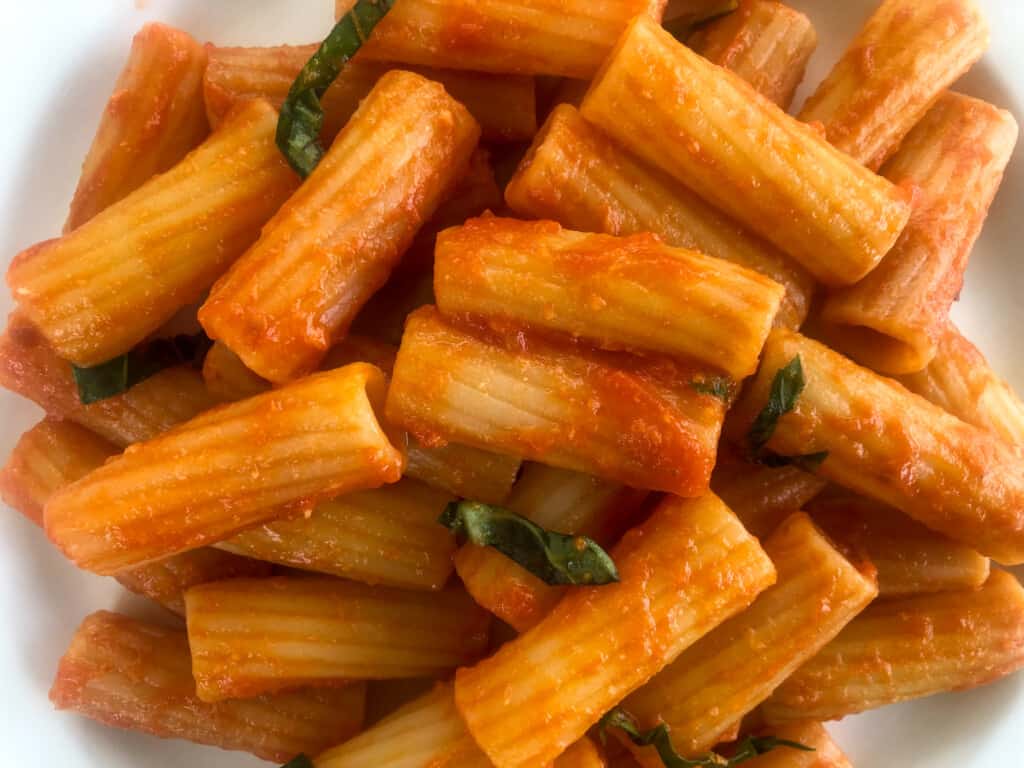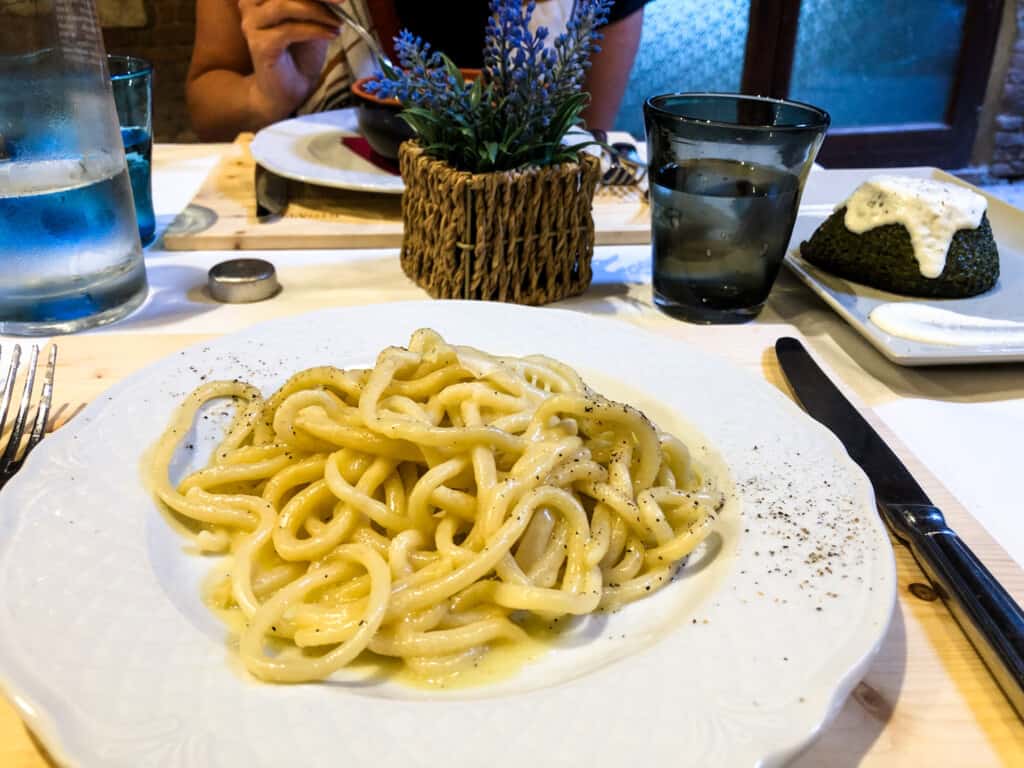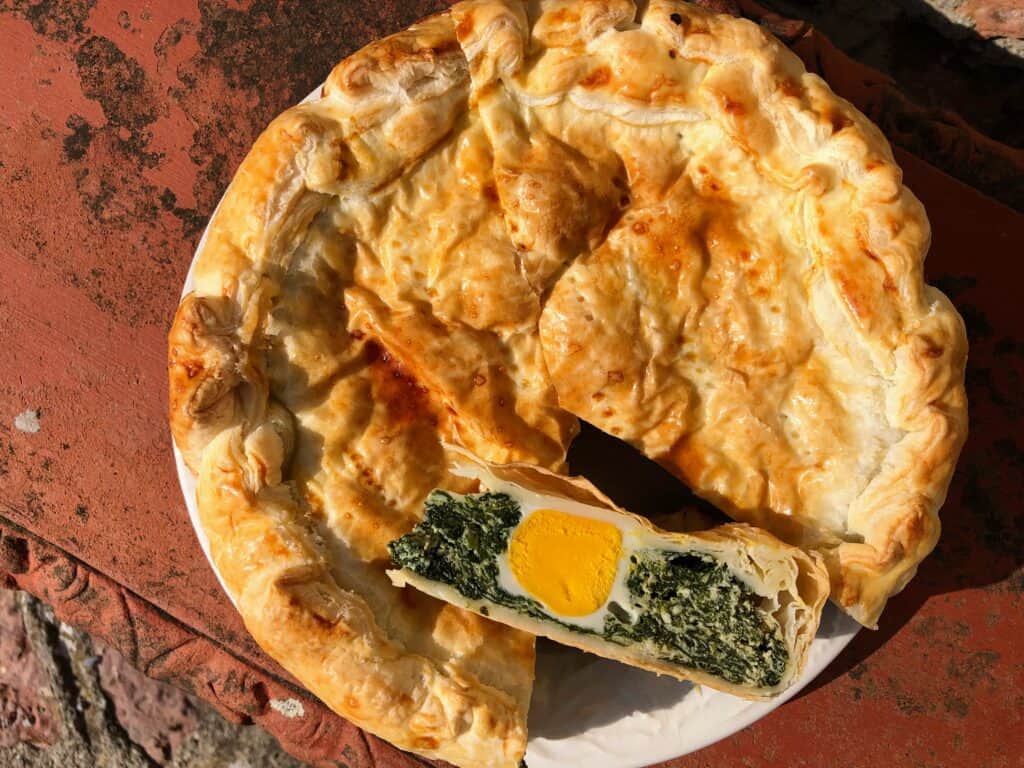Last updated on April 19th, 2024
Are you looking for a way to preserve all the delicious flavor of fresh summer tomatoes?
Do you have a tomato surplus from your garden and can’t find a good use for them?
Consider this fresh pomodoro sauce recipe and enjoy the flavor of summer all winter long!
Homemade fresh pomodoro sauce is a huge tradition here in Italy. You can actually buy tomatoes by the cassetta (crate) to make fresh tomato sauce (and can it if you want to). Most Italians who have a yard will grow tomatoes and make fresh pomodoro sauce for their family to enjoy throughout the entire year.
One of the best things about this fresh pomodoro sauce is that it takes just 20 minutes of chopping and then you sit and let the magic happen. Do nothing more and you have an amazing fresh tomato sauce for your pantry! Or, in the time it takes to boil water and cook pasta, dinner is ready!
Let’s take a look at my Italian family’s recipe for fresh pomodoro sauce – a.k.a. fresh Italian tomato sauce.
Jump to Section
Fresh Pomodoro Sauce Pronunciation

Tomato or pomodoro sauce is pomarola in Italian, pronounced poh-mah-roh-lah.
Listen to the pronunciation of pomarola:
It’s also called sugo di pomodoro, pronounced soo-goh dee poh-mah-doh-roh.
Listen to the pronunciation of sugo di pomodoro:
Nice To Know: Although pomarola and sugo di pomodoro are interchangeable, many Italians associate the word pomarola to tomato sauce made with fresh tomatoes (not canned).
What Is Fresh Pomodoro Sauce?

Fresh Pomodoro sauce is a simple cooked tomato sauce made with very ripe, seasonal tomatoes that are flavored with basic Italian aromi such as carrot, celery, onion, parsley, basil, and olive oil.
Fact: Fresh pomodoro sauce is made without garlic or soffritto. But, if you love garlic, try the Southern Tuscan classic sauce – Aglione Sauce.
Is Fresh Pomodoro Sauce Smooth Or Chunky?

Throughout Italy, the consistency of pomodoro sauce is a personal preference but when it comes to fresh pomodoro sauce made from vine ripe tomatoes, it’s tradition to use a food mill to strain out the majority of tomato seeds and skins.
The ideal consistency of a true fresh pomodoro sauce is best achieved with a food mill, according to any Italian nonna. You can also do this by hand with a sieve and a lot of patience but the process is much easier with a food mill.
You can change the plates on your food mill to control how fine the strain is. Use the plate with larger holes for a thicker, more robust sauce, the medium holes for a “regular sieve” and the small holes for a fine sieve or a very smooth and silky tomato sauce. I prefer the middle sized holes.
If you are looking for a recipe for pomodoro sauce using canned tomatoes read Pomodoro Sauce Recipe – Authentic Tomato Sauce Straight From An Italian Kitchen.
Good To Know: A blender is not a substitute for a food mill in this case because it does not achieve the same consistency as a food mill can.
Olive Oil Or Butter In Fresh Pomodoro Sauce

The biggest difference in fresh pomodoro sauce recipes is the kind of fat in the recipe. Classic pomarola changes from region to region based on what is most commonly used in that area in Italy but most typically when making tomato sauce with fresh tomatoes, olive oil is used.
Why is this? Because in fresh tomato sauce, the additional flavors of carrot, onion, and celery are not fried in the fat. Instead, they are slowly cooked in the juices of the fresh tomatoes, releasing their flavor directly into the sweet tomato juices. Olive oil is added directly into the pot after the tomatoes have started to release all their moisture, preventing any frying from happening.
Fact: In general, Northern Italy uses a lot more butter than in central and Southern Italy because dairy production is huge. Central and Southern Italy, by contrast, uses only extra virgin olive oil in their tomato sauce because olive oil is one of the most diffused crops.
Fresh Pomodoro Sauce Ingredients
Onion

You can really use any kind of onion you like here. Italians always use what is seasonal. Tropea onions, originally from Calabria, are amazing if you can find them. They are purple in color but have a delicate flavor.
Olive Oil
Use extra virgin olive oil if possible. It’s the best quality of oil.
If extra virgin olive oil isn’t an option, use olive oil. Avoid canola or corn oils as they are neutral. Part of what makes fresh Italian pomodoro sauce so good and taste like summer is the taste of olive oil.
The trick to an excellent fresh pomodoro sauce is a lot of olive oil so don’t be afraid of the ⅓ cup in this recipe.
Choosing Olive Oil: If you need help choosing olive oil, read 15 Best Italian Olive Oils – To Enjoy in Italy & Bring Home as a Souvenir and Best Italian Olive Oil Brands in America – Where to Buy Them and How to Store Them.
Tomatoes

Juicey, sun ripe tomatoes are the only option for fresh pomodoro sauce with no substitution. Ripe tomatoes are what makes this sauce so easy and ultimately, cook itself in its own juices.
You can use any kind or variety of tomatoes that you like or you find. I prefer to use tomatoes with a lot of flavor such as beefsteak tomatoes. Other heirloom varieties have a lot of flavor as well but unless you grow them yourself, they can be quite expensive.
This recipe calls for a lot of tomatoes (9 pounds!) because much of the excess water in the tomatoes will evaporate as you slowly simmer the sauce and it becomes more concentrated.
Basil And Parsley

A bit of fresh basil and parsley is key to making fresh Italian pomodoro sauce taste like summer. Do not substitute dried varieties. This recipe is all about freshness!
Other Ingredients
Don’t forget the carrot and celery!
How To Make Fresh Pomodoro Sauce

Wash the tomatoes well and chop them roughly, removing any bad spots and stems. Place them directly into a very large pot.

Roughly cut the carrot, onion, and celery and add to the pot. Wash the herbs and remove large, stalky stems before adding directly in with the other vegetables.

Turn the burner on medium-low and gently start to warm the tomatoes. The juices will start to slowly release, cooking the other vegetables as they do. Season with two teaspoons of salt and add the olive oil. Mix well.
Allow the tomatoes to simmer slowly, uncovered, stirring from time to time to help break up the tomatoes and keep it from sticking to the bottom of the pot. At this point, the longer it cooks, the better it is. You want the sauce to be thick yet not overly dense. If your tomatoes are very juicy (which they should be), the sauce may reduce in volume anywhere from ⅓ to ½! This may take several hours. Season for salt before passing the fresh tomato sauce through a food mill.

Set the food mill over a large bowl and add several scoops of fresh pomodoro sauce. Turn the mill, back-turning from time to time to clear the holes, until all the juices and sauce has been squeezed from the fibers, seeds and skin. Remove the scraps and carry on in this fashion.

Freeze or can according to your personal preference or space allowance.
Best Pomodoro Sauce Substitutions
- Use any kind of onion in equal part such as red, yellow, or white.
- Do not substitute dried basil and parsley for the fresh herbs.
- Use olive oil instead of extra virgin olive oil.
How To Serve Pomodoro Sauce With Pasta

Italians use fresh pomodoro sauce over freshly cooked al dente pasta and is, along with pasta al ragù, true comfort food for Italians. Pasta al pomodoro is often finished on the stovetop, lightly heating the sauce with the actual pasta, which helps the sauce stick.
- Cook pasta according to packaged instructions al dente.
- Meanwhile, gently warm the fresh pomodoro sauce in a wide skillet over low heat.
- Drain the pasta well and add to the skillet with the tomato sauce.
- Cook an additional 1 minute until the pasta is fully coated with the sauce, stirring often. This helps the pomodoro sauce stick to the starch of the pasta.
- Serve immediately with freshly grated parmesan cheese.
Good To Know: Italians never serve plain pasta with the sauce on the side. Authentic pasta dishes will hit the table already dressed in their pasta sauce.
Fact: Fresh pomodoro sauce is an excellent sauce if you want to fare la scarpetta.
What Kind Of Pasta To Serve With Pomodoro Sauce

Fresh Pomodoro sauce is one of the few Italian pasta sauces that can be paired with almost any pasta shape or variety.
These are the most common pasta shapes used with pomodoro sauce:
- Spaghetti
- Penne
- Fusilli
- Maccheroni
- Rigatoni
Notes and Tips For Making Fresh Pomodoro Sauce
- Be careful to keep the fresh tomato sauce at a low simmer as it can burn.
- Stir the pot from time to time to keep the sauce from sticking to the bottom.
- This recipe doubles well for those of us with A TON of tomatoes from our gardens.
- Use two smaller pots if you don’t have one large one. You can then mix it all together in a large bowl once cooked through to ensure a uniform sauce.
How To Store Fresh Pomodoro Sauce

Refrigerating Pomodoro Sauce
Fresh pomodoro sauce can be refrigerated for up to 1 week. Let it come down to room temperature before storing in an airtight container.
Freezing Pomodoro Sauce
Pomodoro can be frozen in individual portions. I like to portion the pomodoro sauce out into dinner-sized batches, enough for about 1 lb or package of pasta. This amount will differ on how much pasta you cook for your family.
Most food safety experts suggest freezing fresh tomato sauce for up to three months but I find mine lasts through the whole winter without contamination or deterioration.
Canning Pomodoro Sauce

Canning pomodoro sauce is one of my favorite ways to store it long term, especially if I am making huge batches.
Canning does take more time and effort as you need to sterilize and process the cans correctly for safe food storage. It’s not as scary and daunting as some make it out to be. You need not have fancy equipment or tools. I can guarantee you that all the Italian grandmas here are just using clean jars, clean lids and fresh pomodoro sauce that has been boiled.
- Clean large, glass jars and matching lids with warm soapy water and allow to air dry on a clean dish towel on the countertop.
- After passing the fresh pomodoro sauce through the food mill, put it back into the pot and bring back up to a boil.
- Distribute evening into the jars, being careful to clean any dribbles on the rim.
- Close the lid tightly and let rest until the jars have cooled and the lids have “popped”, guaranteeing a safely seeded fresh pomodoro sauce.
Do you enjoy making and eating Italian pasta? If so, check out these recipes:
Orecchiette Pasta Recipe
Pici Pasta Recipe – How To Make Tuscany’s Hand Rolled Spaghetti
Tagliatelle Recipe + How to Pronounce It
Cacio e Pepe Recipe – Pronounce it and Make it Like an Italian (+ Audio)
Fresh Pomodoro Sauce Recipe – An Italian Summer Tradition
Pomodoro Sauce Recipe – Made With Canned Tomatoes
Creamy Kale Pasta Recipe
Italian Kale Pesto Recipe
Aglione Sauce Recipe
Pappardelle alla Boscaiola Recipe

Fresh Pomodoro Sauce
Ingredients
- 9 lbs ripe summer tomatoes
- 1 large onion roughly chopped
- 2 large carrots roughly chopped
- 2 celery stalks roughly chopped
- 1/2 bunch flat leaf parsley
- 1/2 bunch basil leaves
- 1/3 cup extra virgin olive oil
- 2 tsp salt
Instructions
- Wash the tomatoes well and chop them roughly, removing any bad spots and stems. Place them directly into a very large pot.
- Roughly cut the carrot, onion, and celery and add to the pot. Wash the herbs and remove large, stalky stems before adding directly in with the other vegetables.
- Turn the burner on medium-low and gently start to warm the tomatoes. The juices will start to slowly release, cooking the other vegetables as they do. Season with two teaspoons of salt and add the olive oil. Mix well.
- Allow the tomatoes to simmer slowly, uncovered, stirring from time to time to help break up the tomatoes and keep it from sticking to the bottom of the pot. At this point, the longer it cooks, the better it is. You want the sauce to be thick yet not overly dense. If your tomatoes are very juicy (which they should be), the sauce may reduce in volume anywhere from ⅓ to ½! This may take several hours. Season for salt before passing the fresh tomato sauce through a food mill.
- Set the food mill over a large bowl and add several scoops of fresh pomodoro sauce. Turn the mill, back-turning from time to time to clear the holes, until all the juices and sauce has been squeezed from the fibers, seeds and skin. Remove the scraps and carry on in this fashion.
- Freeze or can according to your personal preference or space allowance.
Notes
- Be careful to keep the fresh tomato sauce at a low simmer as it can burn.
- Stir the pot from time to time to keep the sauce from sticking to the bottom.
- This recipe doubles well for those of us with A TON of tomatoes from our gardens.
- Use two smaller pots if you don’t have one large one. You can then mix it all together in a large bowl once cooked through to ensure a uniform sauce.
Learn a Trick: Read The Secret Ingredient That Takes Any Pasta Sauce to the Next Level.
Fresh Pomodoro Sauce FAQ
Yes, you can and I suggest you do, especially with summer tomatoes. The only thing you are really doing here is chopping so it only makes sense to chop a bit more and make at least a double batch.
Marinara sauce in Italian is a raw sauce enhanced with olive oil and dried oregano used to make pizza. Fresh Pomodoro sauce is made with very ripe fresh tomatoes that are cooked and used to dress pasta.
A bolognese sauce is a tomato-based meat sauce from Emilia-Romagna. A fresh pomodoro sauce, also known as pomarola, is a simple tomato sauce made from fresh summer vegetables, mostly very ripe tomatoes.




